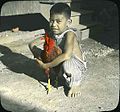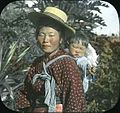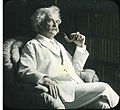|
Ray Jerome Baker
Ray Jerome Baker (December 1, 1880 – October, 1972) was an American photographer, film maker and lecturer. His photographs are among some of the earliest professional works in Humboldt County, California and later in Hawaii where his work focused on the people of that state. BiographyBaker was born near Rockford, Illinois in 1880.[1] From 1898 until 1903 he lived in Saint Paul, Minnesota, where he studied at Mechanic Arts High School and took his first photographs before attending the University of Minnesota for one semester.[1] In 1903, he moved to Portland, Oregon and shortly thereafter, in 1904, to Eureka, California.[1] On his arrival in Eureka, his studio was in a tent until moving into a building at 5th and F Streets where he ran a commercial photography studio and became a lifelong friend of the writer Jack London.[2] Baker regularly toured southern Humboldt County on a motorcycle in the early 20th century.[2] He met Edith Frost, a local school teacher, at a Socialist meeting in Eureka in 1906; they married shortly thereafter.[2] Edith Frost Baker's family had holdings around Briceland and Miranda in southern Humboldt; the Bakers would visit them for the rest of their lives.[2] Baker's photos of southern Humboldt are some of the few images of the early 20th century.[2] During his years living in Humboldt County, Baker built "the Log House" on property that belonged to his mother-in-law who willed it to Baker's only son, Earl Frost Baker.[2] By 1908 he moved his photography business to a new studio at 825 E Street in Eureka and he took his family to Hawaii for the first time.[2] In August, after his return to Eureka, the Eureka Herald mentioned his name several times in connection with a charge of "taking obscene photographs"; he posted $100 bail and ended up paying a $50 fine.[2] In 1910 Baker moved to Honolulu with his wife and son.[3] His studio and darkroom was located at 911 Kalakaua Avenue from 1915 until he retired in 1960.[1] Baker remained active as a photographer and travel lecturer until 1959. He produced thousands of photographic images as black-and-white prints, postcards and books, and as glass plates. When lecturing,[4] Baker used hand-painted lantern slides to dramatize his presentations; he made larger hand-colored glass plates backlit with daylight when exhibited. The glass plate lantern slides and many of the photographs taken by Baker were hand-colored by his wife Edith.[3] Baker traveled to New Zealand and to the U.S. mainland where he visited Mark Twain and Thomas Edison. Otherwise, he spent his time photographing the land, people and plants of Hawaii. He did commercial work for cane and pineapple plantations, and provided tourists arriving on ocean liners with mementos, mostly photographic postcards and bound books of photographs. His photographs appeared in mainstream media, including The National Geographic Magazine,[5] Baker wrote a memoir in 1964, titled Odyssey of a Cameraman.[2] His studies of the Pacific people of Hawaii are an ethnographic and environmental resource. His Racial Patterns in Hawaii and his Familiar Hawaiian Plants, document a changing environment.[6] Ray Jerome Baker died in Honolulu on Friday, October 27, 1972, a funeral was held over his ashes.[7] Collections and archives
Selected works
Studio publications
References
External linksWikimedia Commons has media related to Ray Jerome Baker.
Further reading
|
||||||||||||||
Portal di Ensiklopedia Dunia




